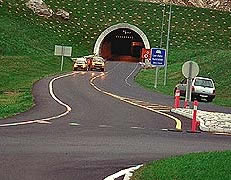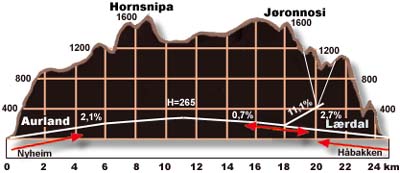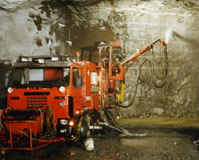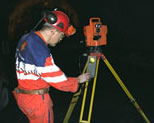In June 1992 the Norwegian Parliament decided that the road between Bergen and Oslo should be built via Aurland, to Laerdal and over Filefjell. The 24,5 kilometre long road tunnel between Aurland and Laerdal represents the final link on the new main highway connecting Oslo and Bergen without ferry connections and difficult mountain crossings during the winter.
Project costs (2000 value): NOK 1082 million
Construction period: 1995-2000
Tunnel length: 24,5 km
Access/ventilation tunnel: 2,1 km
Turning points: 15
Emergency lay-bys: 48
Maximum hourly traffic: 400 vehicles
Average annual daily traffic: 1.000 vehicles |
 |
Fast transport arteries to ensure growth and development in a modern society. In western Norway, this is a greater problem than in the rest of Norway. Narrow roads, combined with many fjord and mountain crossings, lead to relatively poor levels of reliability in road transport.
During the last 20 years, priority has been given to extending the national roads network in order to link different regions of the country more closely together, reduce journey times and provide safer and cheaper transport for businesses. Tunnels, bridges and new road routes make the journey shorter and faster. |
Several long ferry crossing can be dispensed with, and Norway benefits from reliable year-round communications. |

To push through difficult terrain with a high risk of rock falls, it has been necessary in many places to build road tunnels. From an environmental perspective, it also appears that tunnels are a justifiable investment to avoid destroying a beautiful unspoiled natural environment.
- In 1975, the Norwegian Parliament decided that the main road between Bergen and Oslo should go over Filefjell. In 1992, Parliament confirmed that decision, and took a further decision that the road should run through a tunnel between Laerdal and Aurland.
- The Laerdal tunnel is one important part of the extension of a ferry-free, reliable road link between the two largest cities in Norway.
- The 24,5 kilometre-long tunnel is the longest road tunnel in the world. The St. Gotthard tunnel in Switzerland use to hold the title at 16,9 kilometres long.
- During the last 20 years the Norwegian Public Roads Administration has built about 100 kilometres of road tunnels in Sogn og Fjordane. The 11,4 km long Gudvanga tunnel opened in 1991. The Gudvanga tunnel forms part of the main road construction project between Bergen and Oslo.
Modern technology, proven experience, and skills in the construction of such long tunnels have made planning and construction possible.
|
| Geology and Reinforcement |
The dominant type of rock in the Laerdal tunnel is precambrian gneiss. The rock is mostly solid, but there were zones where it was broken and cracked. A few were so distinct at tunnel level that major safety initiatives were necessary while drilling the tunnel.
|
|
|
In passing a weakness zone 10 km from Aurland, there was a huge fall from the roof of the tunnel. A total of around 1,000 cubic metres of rock fell. In order to continue, the entire site of the fall was filled with concrete and a new tunnel was then drilled through the fallen rock and concrete.
Rock burst
The Laerdal tunnel runs deep inside the mountain, with up to 1400 metres of rock above the tunnel. The large masses of rock above the tunnel exert immense pressure. This, combined with the stresses from the horizontal tension in the earth's crust, can lead to large chunks of rock falling from the tunnel's ceiling and walls. This stability fall from the tunnel's roof and walls after blasting. This phenomenon is known as "rock burst".The size of rock burst debris varies from small, thin flakes to huge blocks of stone. The builders of the Laerdal tunnel face this problem frequently. Rock burst |
 |
| debris falls straight after blasting and safety measures must be carried out before any work can continue. |
Scaling and bolting
After each blast, the area excavated was cleared using a hydraulic scalar fitted to an excavator. This is then checked by manual scaling. The roof and walls of the tunnel were then reinforced with galvanised steel bolts and fibre reinforced shotcrete. The 2,5 to 5 metre long rock bolts direct the stresses deeper into the rock, while the shotcrete binds the rock surfaces together between the bolts.
The surface of the tunnel is reinforced and secured by a total of 200.000 rock bolts (7-8 bolts per metre) and 45.000 cubic metres of reinforced shotcrete. This equalizes the stress in the solid rock and makes the Laerdal tunnel safe for motorists.
|
| Constructing the Tunnel |
While the tunnel is being built, operation are divided into four main phases: drilling — laying charges and blasting — loading and transportation — securing the rock. The entire procedure takes about 6-7 hours each time it is carried out. Exactly how long depends primarily on how much safety work is necessary.
Drilling
In the Laerdal tunnel the tunneling was carried out using computer-controlled drilling jumbos as well as traditional drilling and blasting. To make sure that the tunnel section were to meet, with the smallest possible margin of error more than 10 kilometres into the rock and 1000 metres under the mountain, it was important that the drilling and blasting work were carried out with great precision. |
 |
Navigation satellites were used to determine fixed survey points on which other measurements inside the tunnel were based. Inside the tunnel, bearings were indicated using laser beams. A computer on the drilling jumbo captured the laser beams and positioned the drilling equipment automatically, according to a set pattern. Each drilling jumbo contained three automatic hydraulic drills. |
 |
Blasting
Approximately 100 holes, 45 - 51 mm in diameter and 5,2 metres deep, were drilled for each blast. A detonator inside a small stick of dynamite was places in the bottom of each hole. Anolit was then pumped into the hole.
Anolit is the most commonly used explosive in Norwegian tunnels and is more straightforward to use than dynamite. Blasting of the perimeter holes in the tunnel cross-section is carried out cautiously so as to avoid damage to the tunnel crown and walls.
Drilling on the Laerdal tunnel has been carried out from three or four sites (faces) simultaneously, making operations intensive.
- Approximately 5000 blasts were detonated before the breakthrough in September 1999.
- 100 holes were drilled for each blast, (Each blast eats its way 5 metres into the rock).
- Each blast releases 500 cubic metres of rock.
- 500 kg of explosives were used for each blast.
- On average, 60-70 metres were blasted per week at all faces.
- In total, 2,5 million cubic metres of excavated rock are removed from the tunnel.
Loading and transport
Wheel-mounted loaders were used in the tunnel. The excavated materials were transported out of the tunnel using dump trucks. Permanent roads were built in the tunnel, in parallel with the tunneling work, so that transport vehicles could run on a good, paved road base during the construction period. This improved efficiency and minimized pollution.
Excavation and landscaping
The disposal of 2,5 million cubic metres of excavated rock from the tunnel were one of the greatest challenges in planning the tunnel. To avoid major conflicts because of the cultural importance of the landscape and the productive agricultural land in the main valley, the Norwegian Public Roads Administration decided to build more than half of the tunnel from a 2,1 km long access tunnel in Tynjadal. Tynjadal is a side valley, opening out about 8 km east of the town of Laerdal. Here, the excavated materials were deposited with no visible effect on the main valley, and without any risk of hazardous run-off into the Laerdal watercourses.
Building an access tunnel from Tynjadal into the main tunnel were expensive, but made for a shorter construction period than working just from each end. This solution also meant less inconvenience for the Laerdal community, since access traffic and noise from the tunnel workings were concentrated in an uninhabited area. The access tunnel is also an important part of the permanent ventilation system. Polluted air are extracted here — the access tunnel plays a part in reducing the energy consumption of the ventilation system.
|
| Ventilation |
The tunnel between Aurland and Laerdal will be the longest road tunnel so far built in the world when it opens in the year 2000. The total length is 24,5 km. The tunnel is longitudinally ventilated. There is only one ventilation air exhaust shaft, 18 km from the Aurland end of the tunnel. About 10 km from the Aurland end of the tunnel, a cleaning plant for the tunnel ventilation air is installed in a short side tunnel. This plant cleans the passing air for critical polluting components, thus maintaining an acceptable air quality throughout the tunnel even during periods of heavy traffic, thus limiting the air volume and jet from power consumption which is required in order to ventilate the long tunnel satisfactory.
The air cleaning plant consists of an electrostatic precipitator to remove particulate impurities, followed by a gas cleaning plant that removes critical polluting gaseous components from the air.
The upstream electrostatic precipitator is proven technology especially developed for tunnel air cleaning purposes by the Norwegian company CTA, and is highly efficient. It will remove 90-95% of the respiratory particles (PM10) in the air.
The downstream gas cleaning system, delivered by ABB Miljø AS, removes 85-90% of the nitrogen dioxide (NO2) gas and absorbs 60% of the VOC gases (Volatile Organic Compounds — un-combusted remains from gasoline and diesel gases) including 75% or better removal of components like Benzene, and similar aromatic and polyaromatic hydrocarbons (PAHs). Ozone (O3) is removed to 100%.
The gas cleaning process has been developed in cooperation between the Norwegian company ABB Miljø AS and the Norwegian Public Roads Administration. It is based on catalytic reactions which decompose the undesirable gases into nontoxic elements like N2, NO and CO2. Gaseous impurities like CO and NO are not removed, however these components are not present in concentrations that would constitute any hazard to human health. The process has been tested for more than 24,000 hours with actual road tunnel air in the heavily trafficked Oslo tunnel. There has been no loss of catalytic cleaning effect, but de-dusting of the catalyst was required after 16,000 hours for pressure loss reasons. No other special maintenance has been required.
The air quality in the tunnel will be continuously monitored, and the air cleaning system will go automatically into operation when required for air quality reasons. The electrostatic precipitator will be automatically quenched for de-dusting at regular intervals, while maintenance (de-dusting) of the gas filtration catalyst is expected to be required only at intervals of several years.
For the Aurland/Laerdal tunnel the exhausting of spent and polluted air through the ventilation shaft is not a problem. The shaft exhausts in a non-populated area. For city tunnels, where pollution problems are primarily related for the city air quality in general, and more specifically to the contents of dust, NO2 and VOC, this air cleaning technology can advantageously be used to clean the polluted ventilation air from the tunnel before discharge into the urban environment. The fact that cleaned tunnel air may contain relatively high concentrations of NO and CO is not critical in this context. These gases have no toxic or air polluting effects in the concentrations in question, and NO will only react further to NO2 in contact with ozone, which is not or only insignificantly present in a slightly polluted city air.
|
| Tunnel design |
Driving through the Laerdal tunnel will take approximately 20 minutes. The challenge has been to design the tunnel so that people do not find the trip "boring and monotonous", thereby losing concentration during the long journey.
A working group is taking a special look at the design of the tunnel. This work is being led by experienced psychologists at SINTEF (the Industrial and Technological Research Association). Working closely with the Norwegian Public Roads Administration, they will assess what can be done to make the journey through the tunnel a pleasant experience for most people. The creation of a degree of variation during the car journey will reduce the risk of the driver losing concentration and becoming "speed blind".
Since 1990, research has been carried out to study driver behavior in long road tunnels. Simulators are being used to find the best solutions as regards lighting levels and design.
The research results give rise to the following points:
- Gentle curves and short straight sections will make driving through the Laerdal tunnel less monotonous, without breaching the guidelines for safe viewing distance.
- At any given point in the tunnel, the safe viewing distance will be 1000 metres or more.
- The tunnel has been subdivided into four sections by means of specially widened areas which are large enough to allow coaches and trains to turn without having to reverse.
|
| Traffic safety |
A great deal of investment will be put into safety measures and equipment in the Laerdal tunnel. Even through practical experience from several long tunnels shows that tunnels are very safe, a great deal of emphasis has been placed on accident prevention and on having an efficient safety system to cope with potential problems.
Fire safety
Fire safety is a priority in the construction of any tunnel. The Laerdal tunnel goes through dry rock with little need for sealing water seepage. In the few places where flammable plastic mats have been required for waterproofing, these methods were put to the test in a coach fire in the Ekeberg tunnel in 1996. The heat generation was around 35.000 kW, and the temperature below the tunnel roof rose to more than 1000 degrees Celsius with no visible damage occurring to the tunnel cladding.
Emergency equipment
However, even with little risk of accident and safe fire designs, the Laerdal tunnel will be provided with a large quantity of emergency equipment. Emergency telephones and fire extinguishers have been installed at closer intervals that has been usual in other tunnels.
- SOS-marked emergency telephones every 250 metres.
- Fire extinguishers equipment every 125 metres.
- 15 turning points for busses and articulated lorries.
- Signs with the text "Turn and exit" will be illuminated when the turning points are to be used.
- Every 6 kilometres the turnings points are built as a large rock chambers.
- Small lay-bys for breakdowns every 500 metres.
- Separate emergency channels for the police, fire service and medical services.
- Computer links to the emergency service i Laerdal og Bergen.
- Aerial system for P1 radioGSM mobile telephone link.
- Counting and photo systems monitors all traffic in and out the tunnel.
Monitoring
Several million Norwegian kroner will be spent on equipment for monitoring and checking that the ventilation systems, radio connections, lightning systems, traffic lights, emergency equipment, etc., are in working order.
The Norwegian Public Roads Administration's monitoring centre in Laerdal is responsible for monitoring and checking all tunnel systems in the region. Any removal of a fire extinguisher from the monitored tunnels will automatically be recorded.
The air quality will be continuously checked and the fans will start automatically when the concentrations of toxic gases exceed specified levels. The fans can also be operated manually from the monitoring centre.
If any fault should occur in the ventilation system or if any queues should form, creating excessive volumes of exhaust fumes, the tunnel will automatically be closed to traffic.
If a traffic accident or some other situation should occur, requiring the tunnel to be closed, this can be achieved with immediate effect from the monitoring centre. All drivers who have entered the tunnel will be given information via radio about whether they should wait or possibly turn round and drive out of the tunnel. |